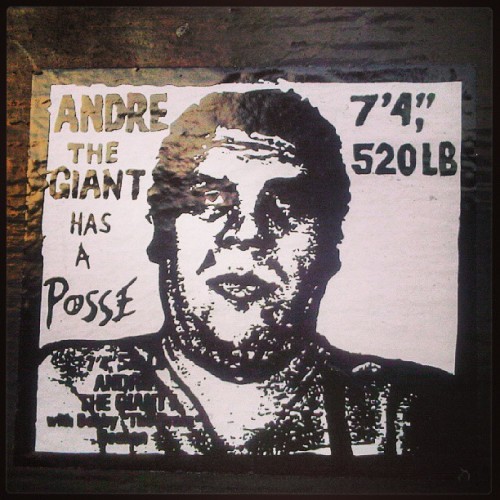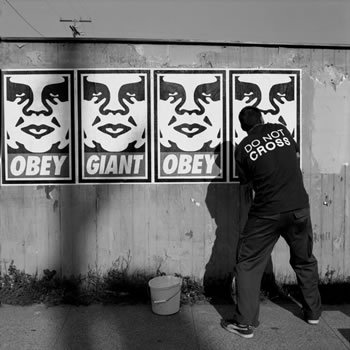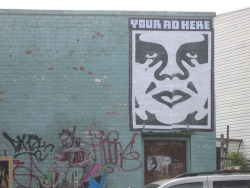From a young age, we are programmed to “obey” society, to follow the current norm. But more often than not, we forget to question what it is that we are actually “obey”-ing? In response to this universal ignorance, in 1989, Shepard Fairey, who then was a college student, decided to conduct an experiment in Phenomenology, a philosophy that urges people to be more mindful of their environment. He intended for his viewers to question the word “Obey” coupled with the face of the infamous wrestler Andre the Giant. Unfortunately, only a mere decade and a half later, Fairey’s work has become a fashion statement rather than a social revolution. People of various demographics stroll around the nation wearing the “Obey Propaganda” trademark without knowing its story, and most importantly, without questioning its purpose.

When Fairey first began his campaign, it was making people question what they were seeing and what it meant, and becoming a successful, interesting example of this unusual concept of Phenomenology. In Banksy’s self directed film “Exit Through the Gift Shop,” Shepard says, “The Andre the Giant thing was an inside joke. But I like the idea that the more stickers there are out there, the more important it seems. The more important it is, the more people wanna know what it is, they more they ask each other and it gains real power from perceived.” Cody Goodfella expands on this statement in a blog post on obeygiant.com when he says,“[Andre] watches from STOP signs and lamp posts, the backs of bus benches, the ceilings of public restrooms. The monolithic gargoyle-image of obey giant is an omnipresent feature on the underbelly of San Diego, an almost microscopic message from an imaginary underground.”

The sticker and logo had no meaning, other than causing people to react and explore their surroundings. And if the Giant is really about anything, it’s about cognizance of the world we live in and the life we lead, and about not letting anyone else control our choices. The Obey Propaganda project illuminates a basic freedom that has silently and latently slipped away. People who post missing dog posters and bills for garage sales are ticketed for vandalizing while ads are encouraged to slither into places where the public eye cannot miss them.
Some people cannot grasp the substantially philosophical meaning under the black and white face on the stickers. They brush Fairey off as a vandalizing graffiti artist. (and sometimes even a cult) And to this he responds, “They don’t even think about the fact that every side of a bus has a poster on it. That’s public property, and they can shove their thing in your face, but you as a taxpayer can’t put up your thing on an electrical box, which is also public property? You wait at the bus stop, and there’s a big mounted poster in there that someone’s paying for, and that money’s going to the city, and do I have any say in where that money’s going? It’s probably going for more parking meters, so I’ll have to pay more to park somewhere.” “It’s gotta be all or nothing,” Fairey declares. “Either I can put my stuff up, and they can put their stuff up, or neither of us can. Billboards are debatable, the stilts are on private property, but it rises up above the horizon, and it’s not behind a curtain, with a sign saying, ‘line up here to see a great ad.’ You can’t avoid it. The whole idea of people not questioning that, and vigilantes with cellphones calling the cops on me, and driving by a billboard and not thinking about it. It’s this programming, this life on autopilot, that I’m trying to get people away from.” (Just some food for thought: What is the line between street art and vandalism? Why is public street art illegal, but public advertising encouraged?)

We have turned Obey into a grueling atrocity of mindless imagery, labeling, and branding that instead of being plastered over roofs and walls to provoke the public eye, is being photo shopped over the eyes of fifteen year olds on social media websites. The symbol, instead of having no apparent explanation and causing question, is now culturally stripped and has just become an indication of “swagger” to this generation.

The Obey Manifesto swears that its purpose is “to catalyze a thoughtful dialogue deconstructing the process of image absorption is the ultimate goal. All in the name of fun and observation. The medium is the message.” But the Obey Propaganda, becoming a clothing label, has completely overshadowed and dismissed the phenomenological aspect of the project. Instead of standing as the icon of curiosity and interest, it’s become completely unquestioned and virtually uniform: a fashion statement rather than that of anything remotely philosophical. The subtly and context is long gone. So while gaining a market value, the Obey Propaganda seems to have lost its purposefulness in our society.

